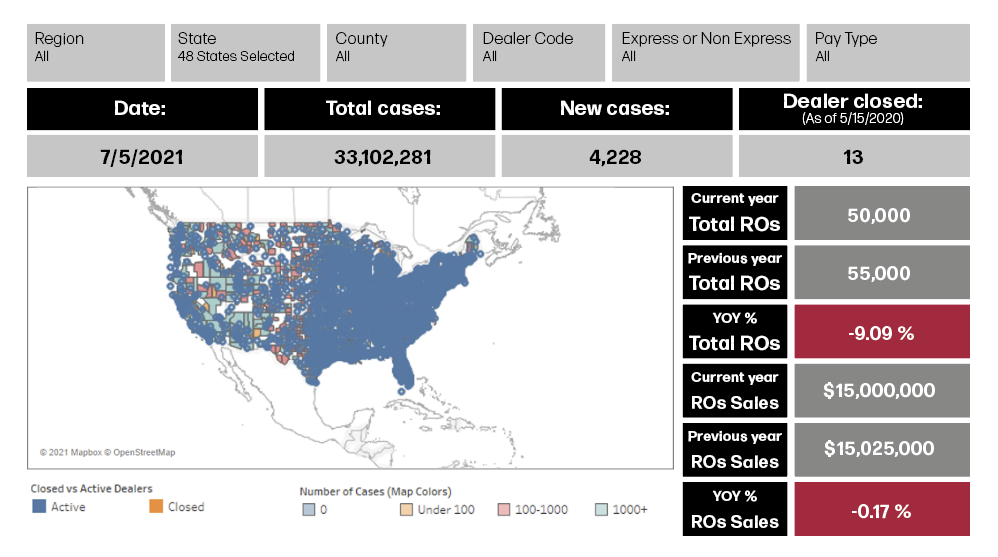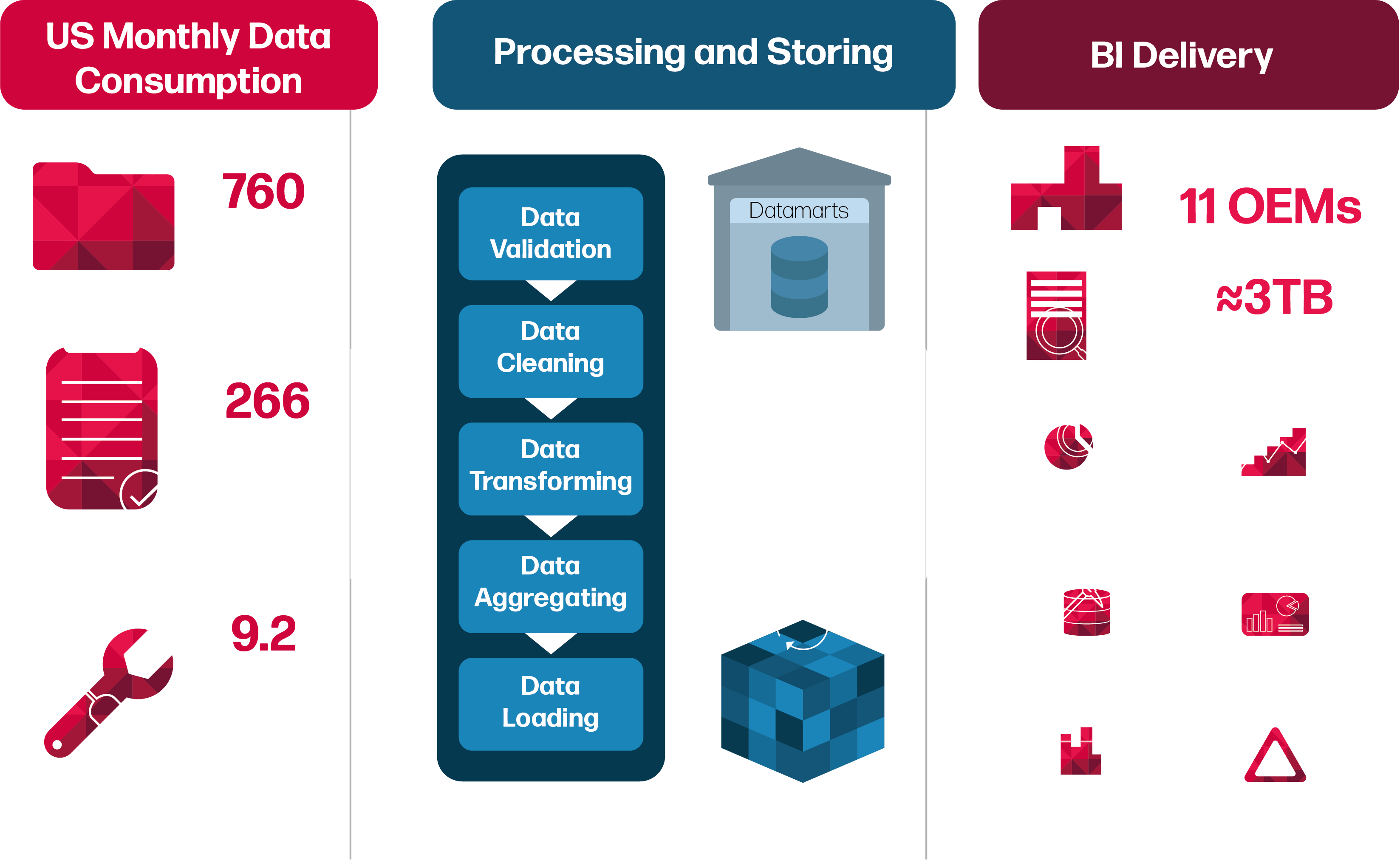
Business Intelligence: Using data to build a customer-led mobility culture

Today’s automotive industry generates immense amounts of data. The proliferation of connected vehicles has given OEMs access to a wealth of information about vehicles, owners, and dealerships. Furthermore, changing customer expectations and the shift to agency models are creating a demand for industry-wide change. This complicated new reality requires a smarter approach to data: Business intelligence (BI). It is no longer enough to collect and analyze data. Today’s OEMs and retailers are challenged to transform data into useful information that can be used by stakeholders to drive better decision making. This can be achieved through the integration of intuitive, easy-to-access dashboards and metrics that present necessary information for making critical business decisions.
“Everyone wants to focus on the technology, but the real focus is on the people.”
The impact of CASE technologies
The ‘connected’ element of CASE technologies has had the greatest effect on business intelligence. Modern vehicles are now equipped with modems which allow detailed data on overall vehicle health, driving habits, route patterns, and more to be gathered in real time. These data streams offer continuous and evolving insights into the business allowing for informed decisions to be made across key areas such as marketing, sales, service and warranty departments.
This wealth of information is also likely to have a significant impact on the future of service. As more vehicles become less mechanical and more technological, organizations will be able to anticipate how service lane KPIs and metrics will change, and make proactive decisions to prepare for the coming maintenance shift that will be required as the market transitions from ICEs to EVs.
Best practices and digital solutions
A successful approach to business intelligence pairs comprehensive analytics with personalized consulting. A true consultative relationship is one that leverages a combination of business knowledge and data to provide actionable recommendations.
It’s important to remember that data is not static, which means that the approach must be adaptable to changes within the market or business at any time. To achieve this, OEMs must adopt an agile methodology that allows for flexible reporting which not only scales with the business, but provides proactive insights to inform future decisions. Through the delivery of relevant intelligence solutions, organizations are able to build the foundation for true partnerships to grow through a portfolio of shared success.
The ultimate goal is to deliver solutions that improve the operations of every customer.
COVID-19 dashboards
At the start of the COVID-19 pandemic, our US analytics team developed a variety of dashboards to help clients understand its impact on their business. Their feedback was very positive and some of the dashboards are still in use, helping clients manage their ongoing operations.

Source: MSX International
COVID-19 dashboards
At the start of the COVID-19 pandemic, our US analytics team developed a variety of dashboards to help clients understand its impact on their business. Their feedback was very positive and some of the dashboards are still in use, helping clients manage their ongoing operations.

Source: Jerry 2022 State of the American Driver
Artificial intelligence and machine learning
Fully autonomous vehicle technology is still years away from being implemented into our daily lives. However, automated technologies are already available in many areas of the automotive industry today. In the warranty claims and management sector, artificial intelligence (AI) and machine learning are helping to reduce the number of manual interventions in the warranty claims process, reducing overhead costs and shortening turnaround times.
We are also seeing sales and post-sale vehicle data being used to create smarter and more targeted customer marketing. Lastly, and perhaps most importantly, AI and machine learning further enhance the agile methodology and consultative approach to BI, allowing OEMs to successfully navigate real-world challenges and events.

AI and machine learning are in the final stages of data maturity within business intelligence. But, to understand how to further leverage this technology and deliver the best results to the customer, we must understand the data maturity model and how it can be applied to deliver better descriptive, predictive, and prescriptive analytics.
The future of business intelligence will heavily depend on the data maturity models being built today. However, there is a common misconception that better analytics and intelligence are a direct result of superior technology and data. This is not wholly true. In the end, it’s the people that matter. A consultative approach to intelligence doesn’t stop with the customer, it extends to the team as well. Different people excel and specialize in different areas, and it’s important that organizations consider this when building a data team.
Within business intelligence, there are many diverse roles to consider in order to produce the best possible product. Data engineers, analysts, scientists, and IT techs all have different strengths and weaknesses. It’s essential to employ specialists in every area who understand their roles, the business logic, and how the customer will ultimately interact with the end product or solution.
Future data maturity models can only be as good as the data that is captured. In an attempt to produce the highest quality data, many organizations and data teams have taken an academic approach to intelligence solutions, but these may not yield realistic or correct results for the business. Academic approaches may work for certain areas within the intelligence sector, but businesses require a different approach, one that caters specifically to the needs of the organization. For this reason, it is critical to position analytics experts and data SMEs well within the business. Those who are on the front lines will have a unique understanding of the business that would be impossible to capture from the outside, resulting in the best data being used. However, having the best intelligence in the world is not enough if it is not shared with other members.
MSX US analytics
A multi-skilled team of data analysts, engineers, scientists and more, support our US clients with a variety of analytics engagements every month.

Source: MSX International
MSX US analytics
A multi-skilled team of data analysts, engineers, scientists and more, support our US clients with a variety of analytics engagements every month.

Source: MSX International
Shared knowledge is better knowledge
Organizations have an opportunity to encourage their members to share key knowledge and best practices to ensure the retention of effective BI solutions and analytics teams. One way to accomplish this is through the development of new platforms that empower their communities by giving them the tools to interact and collaborate on a departmental, institutional, or even global basis. If implemented correctly, OEMs will break down silos and open up communication allowing their members to leverage community knowledge and best practices to build smarter, more effective data for their customers.
What’s next?
It is clear that we now live in a data-driven culture. Just as we rely on data to improve our everyday lives, we can also rely on it to improve our businesses and customer experiences. As OEMs continue to mature their data processing abilities, suppliers can become more collaborative by gaining access to a multitude of data feeds. Business teams will continue to improve their knowledge and leverage the latest technologies to produce the best results, and there is no doubt that new BI technologies and data availability have enabled organizations and individuals to benefit from smarter solutions. But again, it’s the people the matter most.
OEMs have a new challenge ahead: to break down silos, challenge conventions, and empower their members with effective platforms and tools to connect, consult, and communicate. Lastly, they must strategically place data SMEs in roles within the business that allow them to effectively apply their specialties and encourage them to continue to learn and share knowledge and best practices. Ultimately, this approach ensures that the most qualified people are loading the best possible data, which will result in the best outcome for the customer. The future looks smart.
About the Author:
Cory Allen
Director of Digital Solutions, Americas
Cory joined MSX in 2018 and is responsible for overseeing the data, analytics, and development groups for North and South America. Cory supports multiple client programs globally, integrating MSX solutions with new technologies, creative insights, and innovative data analytics. Prior to his role at MSX, Cory has held many senior roles in data analytics and strategy, including Data Acquisition Manager, Global Data Insight and Analytics at Ford Motor Company. He can be reached at callen@msxi.com.




